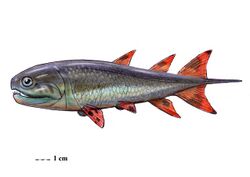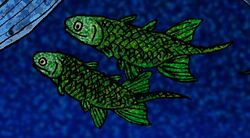Biology:Strunius
| Strunius Temporal range: Late Devonian
| |
|---|---|

| |
| Restoration of S. rolandi | |
| Scientific classification | |
| Missing taxonomy template (fix): | Onychodontidae/? |
| Genus: | †Strunius Jessen, 1966 |
| Type species | |
| †Strunius rolandi Jessen, 1966
| |
Strunius is an extinct genus of lobe-finned fish from the Late Devonian period of Germany.
Although it was a lobe-finned fish, Strunius' fins were supported by fin rays, which are more associated with ray-finned fish. However, its skull was composed of two articulating halves, a feature characteristic of the lobe-finned rhipidistians. The skull was also divided by a deep articulation, with both halves probably connected by a large muscle, increasing the power of the bite.[1] The same system is seen in coelacanths and the better-known Eusthenopteron.
Compared to other lobe-finned fishes, Strunius had a rather short, stubby body, and was just 10 centimetres (4 in) long. It was covered in large, round, bony scales, and probably fed on other fishes.[1]
References
- ↑ 1.0 1.1 Palmer, D., ed (1999). The Marshall Illustrated Encyclopedia of Dinosaurs and Prehistoric Animals. London: Marshall Editions. p. 42. ISBN 1-84028-152-9.
Wikidata ☰ Q3699097 entry
 |


